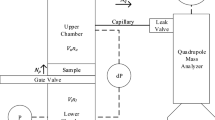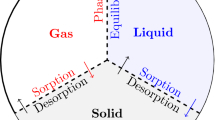Abstract
The interaction of xenon with containment barriers can play a crucial role in the detection of underground nuclear explosions. Independent field experiments and laboratory-derived models have observed depressed surface level xenon concentrations and subsequently predicted geological capture rates. This work sought to experimentally verify those predictions by analyzing xenon transport though a two-bulb diffusion apparatus adapted for the study of geologic media. Novel to this work is the timescale over which these experiments were carried out, allowing the system to reach equilibrium, rather than relying on numerical models to treat the equilibrium concentration of each gas as a fit coefficient.




Similar content being viewed by others
References
Mason LR, Bohner JD, Williams DL (1998) Airborne anthropogenic radioactivity measurements from an international radionuclide monitoring system. J Radioanal Nucl Chem 235:71–75. https://doi.org/10.1007/BF02385940
Bowyer TW, Abel KH, Hensley WK et al (1997) Ambient Xe-133 Levels in the Northeast US. J Environ Radioact 37:143–153. https://doi.org/10.1016/S0265-931X(97)00005-2
Perkins RW, Casey LA (1996) Radioxenons: their role in monitoring a comprehensive test ban treaty. Dept. Energy, Richland, WA, USA DOE/RL-96–51
Lowrey JD, Biegalski SR, Osborne AG, Deinert MR (2013) Subsurface mass transport affects the radioxenon signatures that are used to identify clandestine nuclear tests. Geophys Res Lett 40:111–115. https://doi.org/10.1029/2012GL053885
Ringbom A, Elmgren K, Lindh K et al (2009) Measurements of radioxenon in ground level air in South Korea following the claimed nuclear test in North Korea on October 9, 2006. J Radioanal Nucl Chem 282:773–779
Ringbom A, Axelsson A, Aldener M et al (2013) Analysis of radioxenon samples likely connected to the announced nuclear test conducted by DPRK on February 12, 2013. In: American Geophysical Union, Fall Meeting 2013
Auer M, Axelsson A, Blanchard X et al (2004) Intercomparison experiments of systems for the measurement of xenon radionuclides in the atmosphere. Appl Radiat Isot 60:863–877. https://doi.org/10.1016/j.apradiso.2004.01.011
Olsen KB, Kirkham RR, Woods VT et al (2016) Noble gas migration experiment to support the detection of underground nuclear explosions. J Radioanal Nucl Chem 307:2603–2610. https://doi.org/10.1007/s10967-015-4639-7
Carrigan CR, Heinle RA, Hudson GB et al (1996) Trace gas emissions on geological faults as indicators of underground nuclear testing. Nature 382:528–531
Robertson J. (1969) Behavior of Xenon-133 gas after injection underground: molecular diffusion, materials balance, and barometric pressure effects. US Geol Surv Open-File Rep IDO-22051
Paul MJ, Biegalski SR, Haas DA et al (2018) Xenon adsorption on geological media and implications for radionuclide signatures. J Environ Radioact 187:65–72. https://doi.org/10.1016/j.jenvrad.2018.01.029
Paul MJ, Biegalski SR, Haas DA, Lowrey J (2018) Adsorptive transport of noble gas tracers in porous media. Int J Mod Phys Conf Ser Appl Nucl Tech 48:1860124-1–1860124-10. https://doi.org/10.1142/S2010194518601242
Ney EP, Armistead FC (1947) The self-diffusion coefficient of uranium hexafluoride. Phys Rev 71:14–19
Byers MF, Paul MJ, Haas DA et al (2018) Evaluation of carbon tetrafluoride as a xenon surrogate for underground gas transport. J Radioanal Nucl Chem 3:465–470
Paul MJ (2017) Transport and sorption of noble gases in porous geological media. University of Texas
Acknowledgements
The authors gratefully thank the U.S. Department of Energy (DOE), National Nuclear Security Administration, Office of Defense Nuclear Nonproliferation (DNN) Research and Development for their financial support.
Author information
Authors and Affiliations
Corresponding author
Additional information
Publisher's Note
Springer Nature remains neutral with regard to jurisdictional claims in published maps and institutional affiliations.
Appendix
Appendix
The sample retrieval process was automated by coupling the 2-bulb diffusion apparatus to the GCMS via a programmable gas sampling valve purchased from Shimadzu. Stainless steel transfer tubing, with segments measuring 1/16″ in diameter and 64.75″ in total length and 11″ of tubing measuring 1/8″ in diameter, with an inert coating was used to plumb the top bulb of the transport column to the valve. During normal operation the valve utilizes a flow-through sampling chamber, sized to be approximately 50 µL, to create a closed loop connecting the outlet tubing from the top bulb back to its inlet. When a sample is desired the valve turns, isolating the gases contained in the sampling chamber and directly connecting the two sections of tubing coming into and out of the top bulb of the transport column. Helium carrier gas is then used to push the contents of the sampling chamber to the GCMS for analysis.
Initial characterization experiments proved however that additional modifications would be necessary to get the physics of the newly automated system to match those of the previous manual trials, characterized by the representative data set shown in Fig. 5. A series of experiments were conducted in order to ultimately achieve an analogous automated system by comparing the diffusive behavior of xenon, carbon tetrafluoride, and sulfur hexafluoride in comparison to the manual system.
The first trial successfully utilizing the automated sample retrieval system resulted in the gas species showing transport characteristics that differed from trials utilizing manual sample collection, which can be seen in the upper left-hand corner of Fig. 6.
It was hypothesized that due to a lack of flow throughout the transport column and loop connecting it to the sampling valve, the volumes of gas contained in the sample chamber were not directly reflective of the time dependent behavior in the top bulb. Therefore, two different inline gas pumps (manufactured by TCS and Parker) were iteratively added to introduce circulation to the system. The induced flow rate was varied, via the input voltage to the pump, but this also appeared to be perturbing the system, as can be seen in the two right-most plots in Fig. 6 where it appears that excessive flow in the top bulb drives gas species to higher equilibrium concentrations.
Instead of continuous circulation it was determined that the pumping time should be limited to short intervals directly proceeding sample collection. The duration of pumping was iteratively decreased, as can be seen in the two bottom rows of data in Fig. 7. This intermittent pumping regime however observed transient abnormalities in the time series concentrations across all gas species. This was hypothesized to be a result of inconsistency amongst the short reset time required by the GCMS between sample analysis. Under previous conditions, both manual and automated with continuous pumping, this short time window, on the order of tens of seconds, did not prove troublesome as the data analysis code harvests the time stamp from the GCMS datafile directly, providing an accurate time series. In the case of an externally controlled circulation pump however, the inconsistent reset time resulted in inconsistent time windows between circulation and sampling, in some cases perturbing the sample analysis. This issue was circumvented by utilizing a LabView code capable of controlling the circulatory pump based off a trigger initiated by the GCMS. With this new control system in place the voltage supplied to the pump, an easily manipulatable surrogate for flow rate, and time of pumping were tuned until the diffusive behavior of the three gases of interest replicated what was observed in the manual trials, as seen in the plot in the bottom right corner of Fig. 7.
Rights and permissions
About this article
Cite this article
Byers, M.F., Haas, D.A., Barth, B.S. et al. Adsorption of tracer gases in geological media: experimental benchmarking. J Radioanal Nucl Chem 322, 1621–1626 (2019). https://doi.org/10.1007/s10967-019-06768-3
Received:
Published:
Issue Date:
DOI: https://doi.org/10.1007/s10967-019-06768-3







